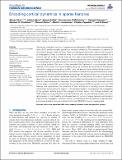Encoding Cortical Dynamics in Sparse Features
Author(s)
Khan, Sheraz; Lefevre, Julien; Baillet, Sylvain; Michmizos, Konstantinos; Ganesan, Santosh; Kitzbichler, Manfred G.; Zetino, Manuel; Hamalainen, Matti S.; Papadelis, Christos; Kenet, Tal; ... Show more Show less
DownloadKhan-2014-Encoding cortical dy.pdf (1.667Mb)
PUBLISHER_POLICY
Publisher Policy
Article is made available in accordance with the publisher's policy and may be subject to US copyright law. Please refer to the publisher's site for terms of use.
Terms of use
Metadata
Show full item recordAbstract
Distributed cortical solutions of magnetoencephalography (MEG) and electroencephalography (EEG) exhibit complex spatial and temporal dynamics. The extraction of patterns of interest and dynamic features from these cortical signals has so far relied on the expertise of investigators. There is a definite need in both clinical and neuroscience research for a method that will extract critical features from high-dimensional neuroimaging data in an automatic fashion. We have previously demonstrated the use of optical flow techniques for evaluating the kinematic properties of motion field projected on non-flat manifolds like in a cortical surface. We have further extended this framework to automatically detect features in the optical flow vector field by using the modified and extended 2-Riemannian Helmholtz–Hodge decomposition (HHD). Here, we applied these mathematical models on simulation and MEG data recorded from a healthy individual during a somatosensory experiment and an epilepsy pediatric patient during sleep. We tested whether our technique can automatically extract salient dynamical features of cortical activity. Simulation results indicated that we can precisely reproduce the simulated cortical dynamics with HHD; encode them in sparse features and represent the propagation of brain activity between distinct cortical areas. Using HHD, we decoded the somatosensory N20 component into two HHD features and represented the dynamics of brain activity as a traveling source between two primary somatosensory regions. In the epilepsy patient, we displayed the propagation of the epileptic activity around the margins of a brain lesion. Our findings indicate that HHD measures computed from cortical dynamics can: (i) quantitatively access the cortical dynamics in both healthy and disease brain in terms of sparse features and dynamic brain activity propagation between distinct cortical areas, and (ii) facilitate a reproducible, automated analysis of experimental and clinical MEG/EEG source imaging data.
Date issued
2014-05Department
McGovern Institute for Brain Research at MITJournal
Frontiers in Human Neuroscience
Publisher
Frontiers Research Foundation
Citation
Khan, Sheraz, Julien Lefevre, Sylvain Baillet, Konstantinos P. Michmizos, Santosh Ganesan, Manfred G. Kitzbichler, Manuel Zetino, Matti S. Hamalainen, Christos Papadelis, and Tal Kenet. “Encoding Cortical Dynamics in Sparse Features.” Frontiers in Human Neuroscience 8 (May 23, 2014).
Version: Final published version
ISSN
1662-5161